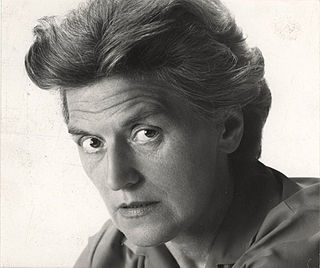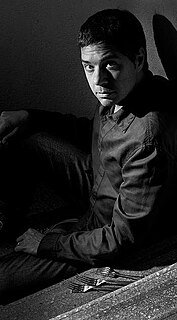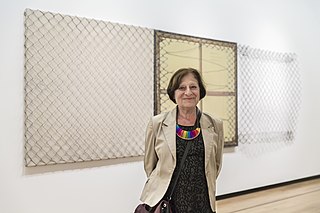
Recoleta is a barrio or neighborhood of Buenos Aires, Argentina, located in the northern part of the city, by the Río de la Plata. The area is perhaps best known to be the home of the distinguished Recoleta Cemetery. It is a traditional upper-class and conservative neighborhood with some of the priciest real estate in the city, known for Paris-style townhouses, lavish former palaces and posh boutiques.

Clorindo Manuel José Testa was an Italian-Argentine architect and artist.
Alfredo Prior is a painter, writer, performer and musician. His career began at the age of 18 with his first solo exhibition in Buenos Aires, where he still lives and works.

Leopoldo Presas (1915-2009) was an Argentine artist. He experienced different styles throughout his life. He had academic training and started as a figurative painter though he later turned into expressionism as well. He tried several mediums as oil, tempera, charcoal and pencil on different supports including canvas, paper, paperboard and newspaper. The themes of his works have been very extensive. The female figure was his main attraction, but he also did still lifes, landscapes, harbors, erotic paintings and some expressionist and controversial series as “The Pigs”, “The Kings of Putrefaction” and “The Christs”. He won the Konex Award in 1982 and 2012.

Liliana Porter is a contemporary artist working in a wide variety of media, including photography, printmaking, painting, drawing, installation, video, theater, and public art.

Annemarie Heinrich was a German-born naturalized Argentine photographer, who specialized in portraits and nude photographs. Heinrich is considered one of Argentina's most important photographers.

Rogelio Polesello was an Argentine painter, muralist and sculptor. He was best known for making Op art known in Latin America. He won two Konex Awards; one in 1982 and another in 2012. He was born in Buenos Aires.

Marcelo Pombo is an Argentine artist. His work is in the collections of the Museo Nacional de Bellas Artes, the Museo de Arte Moderno de Buenos Aires, the MALBA, Museo de Arte Latinoamericano de Buenos Aires, the Museo Castagnino + macro, the Blanton Museum of Art of The University of Texas at Austin, among others.

Sergio Castiglione is an Argentine photographer. He has exhibited his work in Argentina as well as abroad. He mainly focuses on urban exploration, travel, and architectural photography.
Nora Aslan is an Argentine visual artist and photographer, known for tapestry design and collage. Her work has been compared to that of Max Ernst, Fred Tomaselli, Hieronymus Bosch, and Matthias Grünewald.
Elbio Raúl Lozza was an Argentinian painter, draughtsman, designer, journalist, and theorist who was part of the concrete art movement. He was part of the Asociación Arte Concreto-Invención. He was the founder of the Perceptivist group. He was granted the Platinum Konex Award in Visual Arts from Argentina in 1992.
Inés Katzenstein is an Argentine curator, art historian, and art critic who specializes in Latin American art.
Alicia D’Amico was an Argentinian photographer. She was born in Buenos Aires, where her family had a photographic business. She ran a very productive studio with Sara Facio for twenty years. She published photography books and for the last twenty years of her life she focused on feminist issues and personal projects about the role of women in photography. She dedicated her entire life to photography, and she became a leading figure in Argentinian photography.
Liliana Maresca was an Argentine artist. Her works cover a variety of styles including sculpture, painting, graphic montages art objects and installations. She was a prominent artist in the period following the dictatorship of the National Reorganization Process. She was a key figure who participated in the artistic scene since the early 80's, starring the enthusiastic young bohemian that detonated Buenos Aires from the early years of democracy rapidly becoming an inflection figure. Her works included objects, installations, performances, interventions in public and semipublic places, and the photographic performances. Maresca died of AIDS in 1994, just a few days after the opening of her retrospective at the Centro Cultural Recoleta in Buenos Aires.

Diana Dowek is a visual artist, known for one of her first series, denoting her engagement in human rights movements. Dowek also was a founder of the Association of Visual Artists of the Republic of Argentina (AVARA) and is now a Vice President.

Andrea Graciela Giunta is an Argentine art historian, professor, researcher, and curator.
Diego Bianchi is an Argentinian visual artist. He lives and works in Buenos Aires, Argentina.

Fabiana Barreda is an Argentine photographer, performer, installationist and multimedia artist. Her work specializes in the body, desire and politics of gender. She has participated in national and international exhibitions, being the most important ones in places such as Museum of Modern Art, New York University (USA), International Architecture Biennale Rotterdam (Netherlands), Telefonica Foundation of Madrid (Spain) and Museum of Monterrey - MACO (Mexico).

Silvia Rivas is an Argentine visual artist known for her multi-channel video installations. In Latin America she is considered a precursor in the area of expanded video. Her work is characterized by the crossing of materialities and technologies in which she uses both electronic devices and ancestral techniques. Her production is organized in thematic series of video installations, drawings, photographs or objects. Interested in revealing the metaphorical power of different materialities, she uses the electronic medium and the moving image to record stillness, the imminent and the subjective perception of time.
Rosa Faccaro was an Argentine art critic, painter and university teacher who specialised in Contemporary art, Pre-Columbian art and textile art. She received several awards for her work, was curator of multiple art exhibitions and was a jury member of many international and national awards. Faccaro collaborated to the artistic section of the newspaper Clarín from 1979 to 2000.












